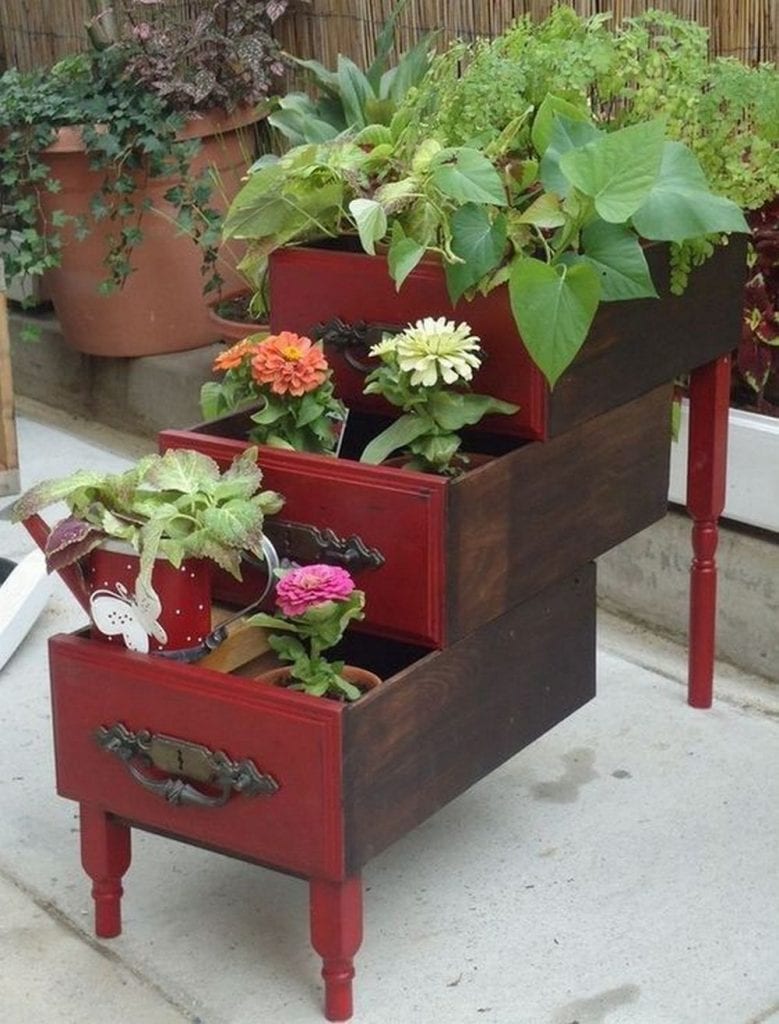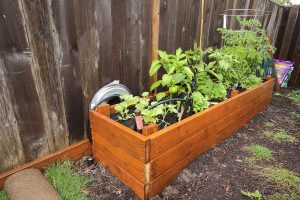Last Updated on March 27, 2024 by teamobn
We love things that make our life easier, even if it’s as simple as watering plants. Being busy, it’s easy to forget such chores. If you’ve been dealing with dying plants because you forget to water them, here’s a DIY self-watering planter project that will be very useful for you. Plus, it’s an easy build.
When a dresser has outlived its usefulness, you are likely to stow it away in the storage or do away with it altogether. A dresser holds clothes. If it can’t do that anymore, what’s the point in keeping it?

Well, this self-watering planter is a great way to bring new life to old dresser drawers that you’re no longer using. You can repurpose them, paint and design them in any way you want. Put them up outside your house and they’ll liven up space.
If you have old dresser drawers that have been sitting in storage for so long, it’s time to take them out. Don’t let the long list of materials intimidate you. This is an easy project with big benefits.
Making Self-Watering Planters from Dresser Drawers
Contents
Materials
- Dresser Drawers
- 1 pc – 2″ diameter PVC Pipe (length equivalent of the total height of all drawers stacked)
- 3 pcs – 3″ diameter ABS Pipe (1/3 of total height)
- 2 pcs – Plastic Baskets (something stiff and porous enough to serve as a non-toxic, water-proof, weight-bearing screen)
- Outdoor Stain & Sealant Combo Wood Finish
- Wood Glue
- Wire, String or Cable Ties
- Landscape Tarp, Opaque Plastic Bag or River Rocks
- Potting Mix
- Fertilizer
- Plants or Seeds
- Painter’s Tape
- Old Newspapers (for easy cleanup)
Tools
- Paintbrush
- Drill
- Utility Knife
- Garden Trowel
Instruction
Prepare the Drawer
- Start by cleaning the dresser drawer thoroughly. Remove any hardware and sand down rough edges to create a smooth surface.
- Apply outdoor stain and sealant combo wood finish using a paintbrush. This will protect the wood from water damage and weathering. Allow it to dry as per the product’s instructions.
Modify the Drawer for Water Reservoir
- Determine the placement for your PVC and ABS pipes. The 2″ diameter PVC pipe will act as the water reservoir, and the 3″ ABS pipes will support the soil and allow roots to access water.
- Use a drill and a utility knife to create holes at the bottom of the drawer for the PVC and ABS pipes. Ensure the holes are slightly smaller than the diameter of the pipes for a snug fit.
Install the Water Reservoir
- Cut the 2″ diameter PVC pipe so that its length matches the total height of the drawer. You’re going to create holes for the water to come out from by drilling them onto the PVC pipe.
- Place the PVC pipe in the hole prepared for it, positioning it at one end of the drawer.
Add Support Pipes
- Cut the 3 pcs of 3″ diameter ABS pipe into lengths equal to one-third the total height of the drawer. These will support the weight of the soil and help distribute water.
- Install these ABS pipes into their designated holes in the drawer.
Prepare the Watering System
- Fit plastic baskets over the top of the ABS pipes. These baskets should be porous enough to allow water through but sturdy to support the potting mix.
- If necessary, use wire, string, or cable ties to secure the baskets to the pipes.
Create a Drainage Layer
- Line the bottom of the drawer around the pipes with landscape tarp, an opaque plastic bag, or river rocks. This layer prevents soil from entering the water reservoir while allowing water to pass through.
Fill With Soil and Plant
- Mix potting soil with fertilizer according to package instructions. Fill the drawer with the potting mix, ensuring it reaches into the baskets but does not overfill the drawer.
- Plant your plants or seeds into the soil. Use a garden trowel for planting and ensure even spacing according to the plants’ needs.
Watering the Planter
- Fill the PVC pipe with water until it reaches the top. The water will seep out slowly, providing a consistent moisture source for your plants.
- Check the water level periodically and refill as needed to ensure your plants are adequately watered.
Final Touches
- Use painter’s tape to create designs or borders if you wish to add more decoration to your planter. Apply additional coats of stain and sealant if desired.
- Place old newspapers underneath the planter during the project for easy cleanup.
Click on any image to start the lightbox display. Use your Esc key to close the lightbox.
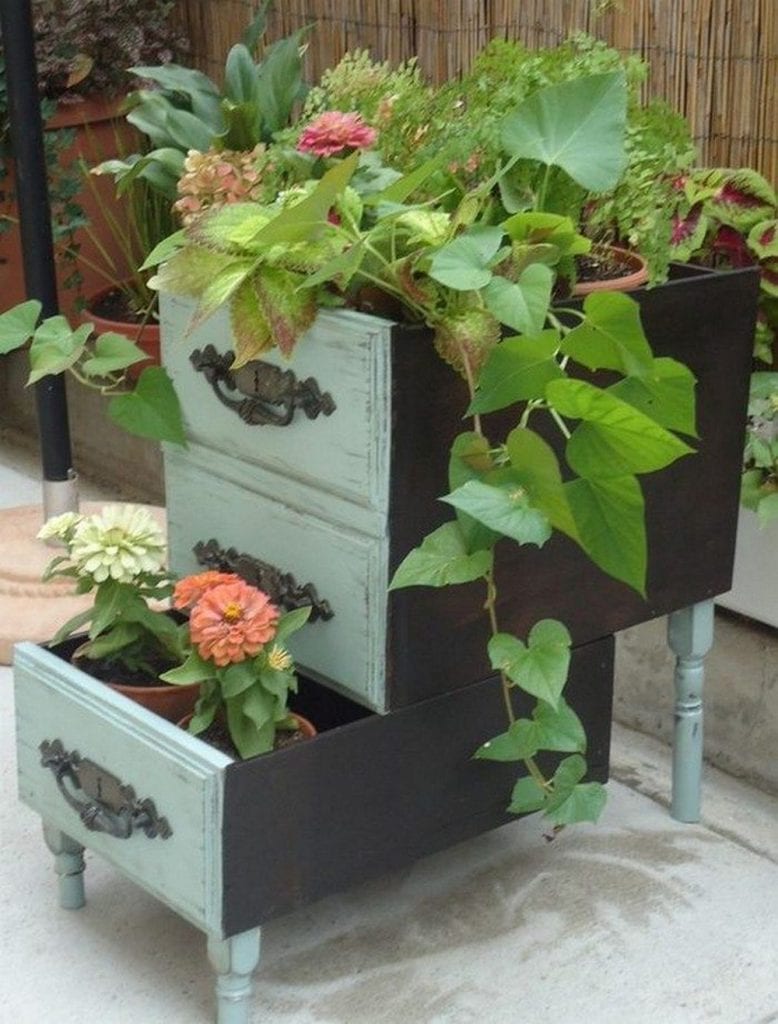
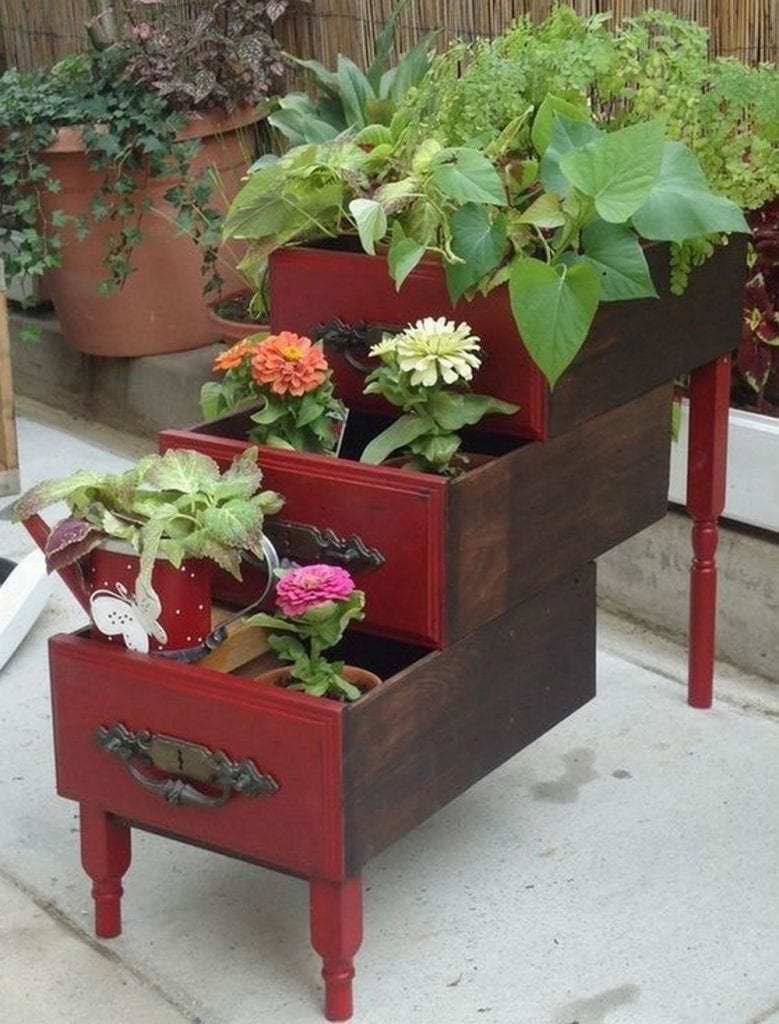
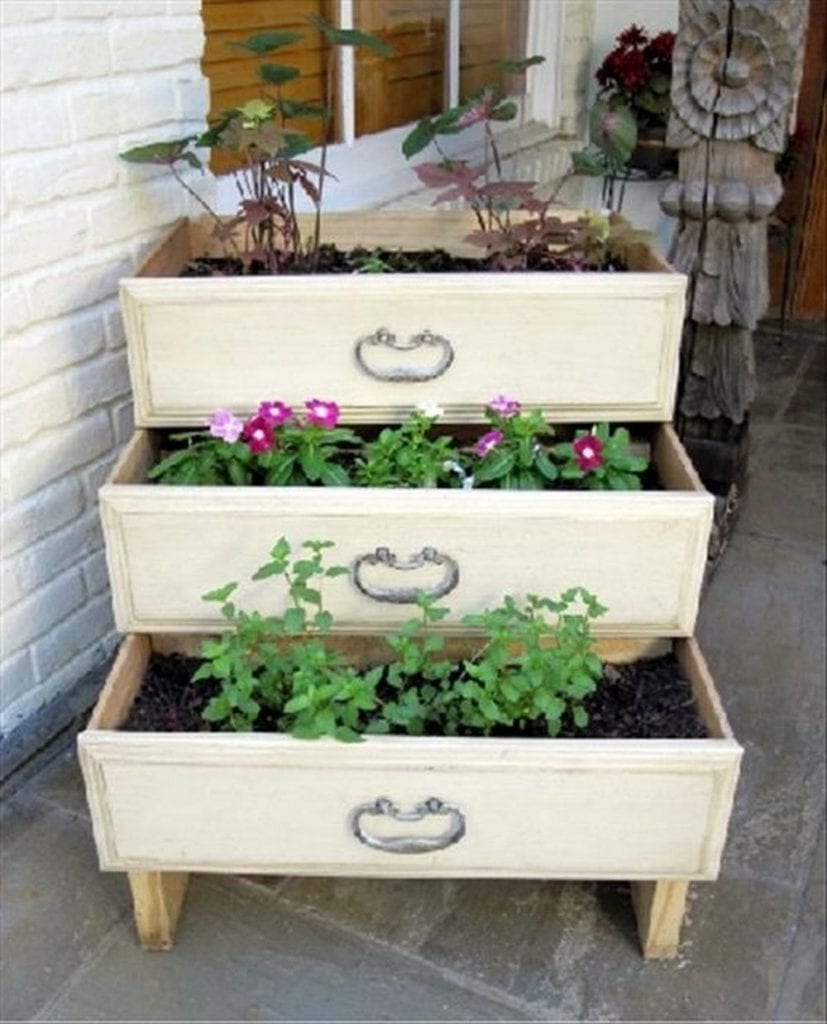
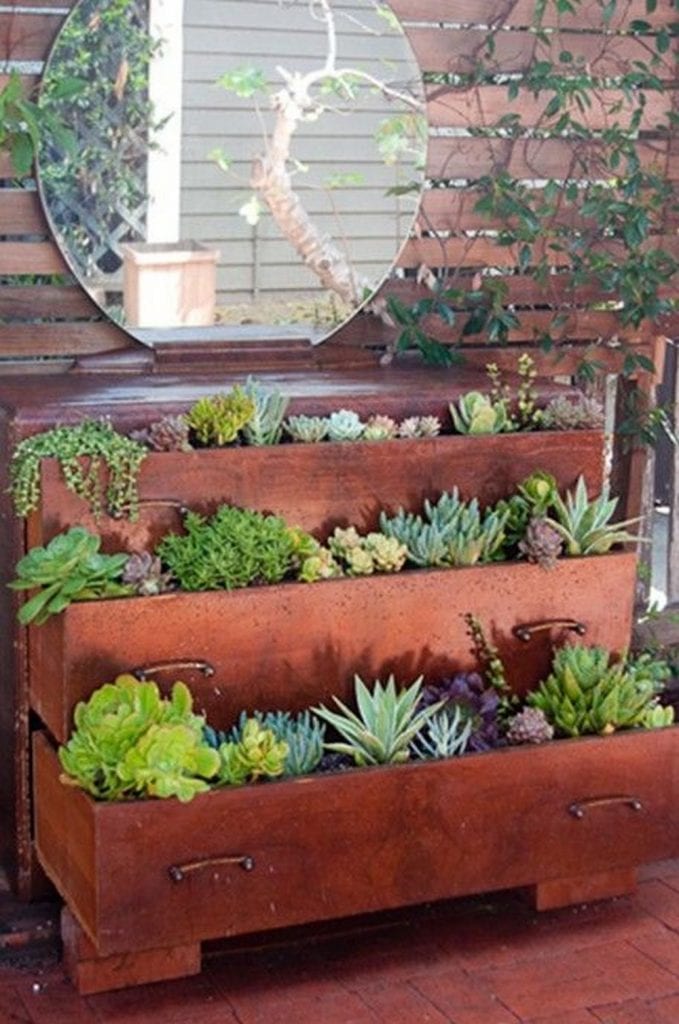

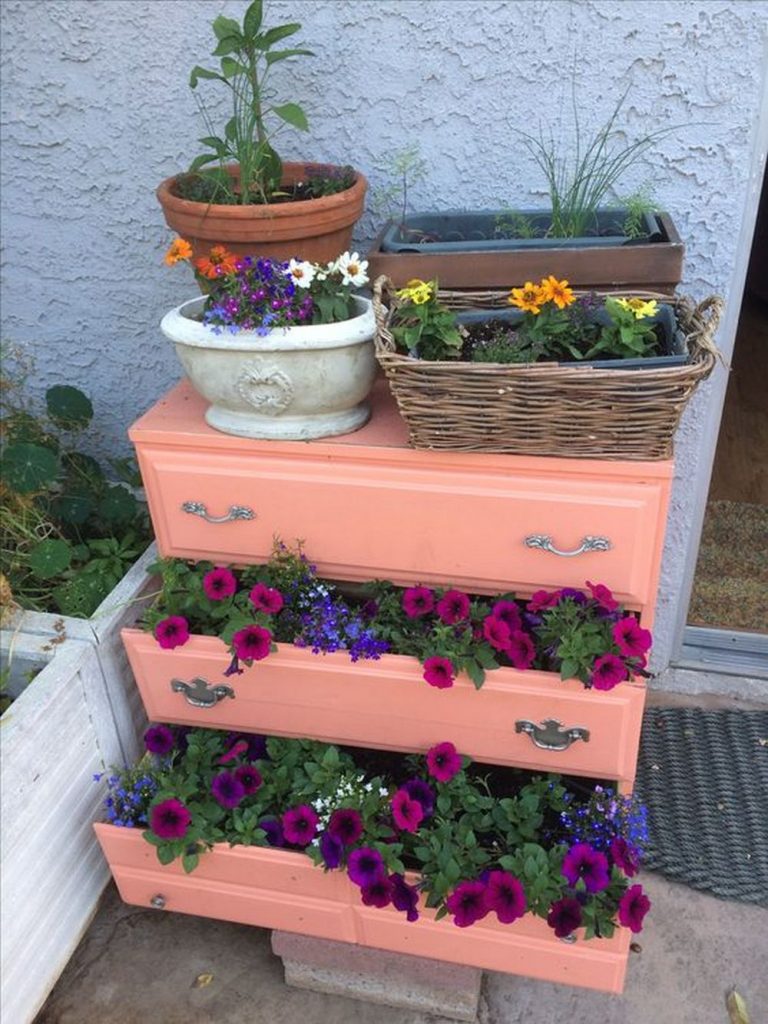
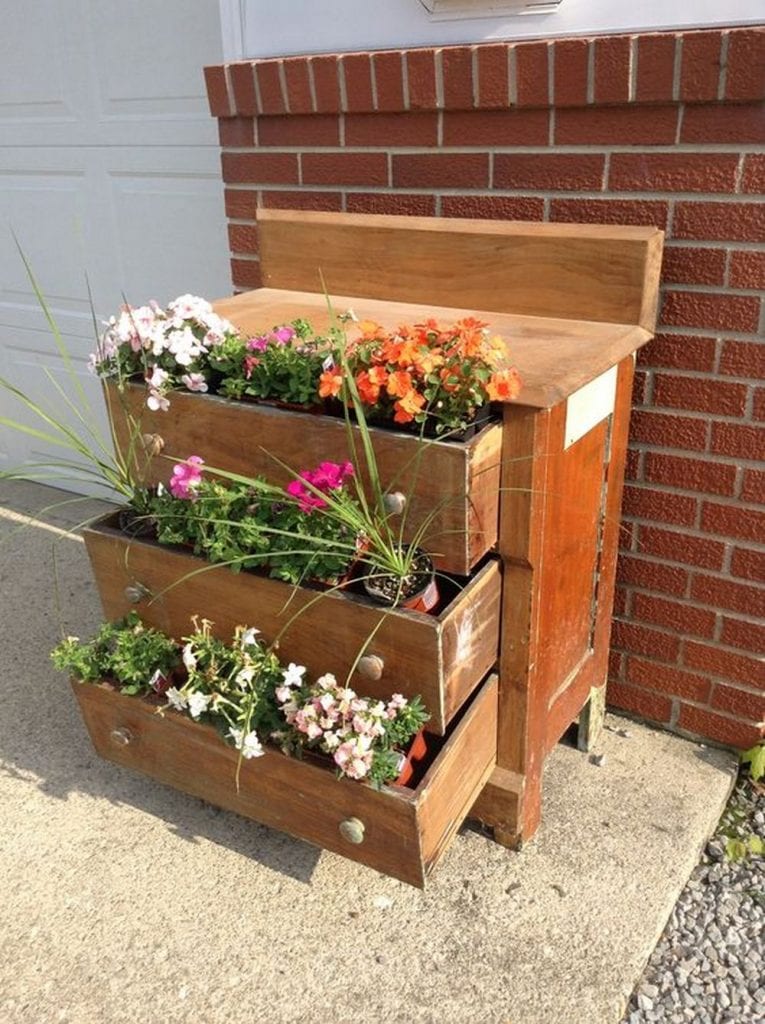

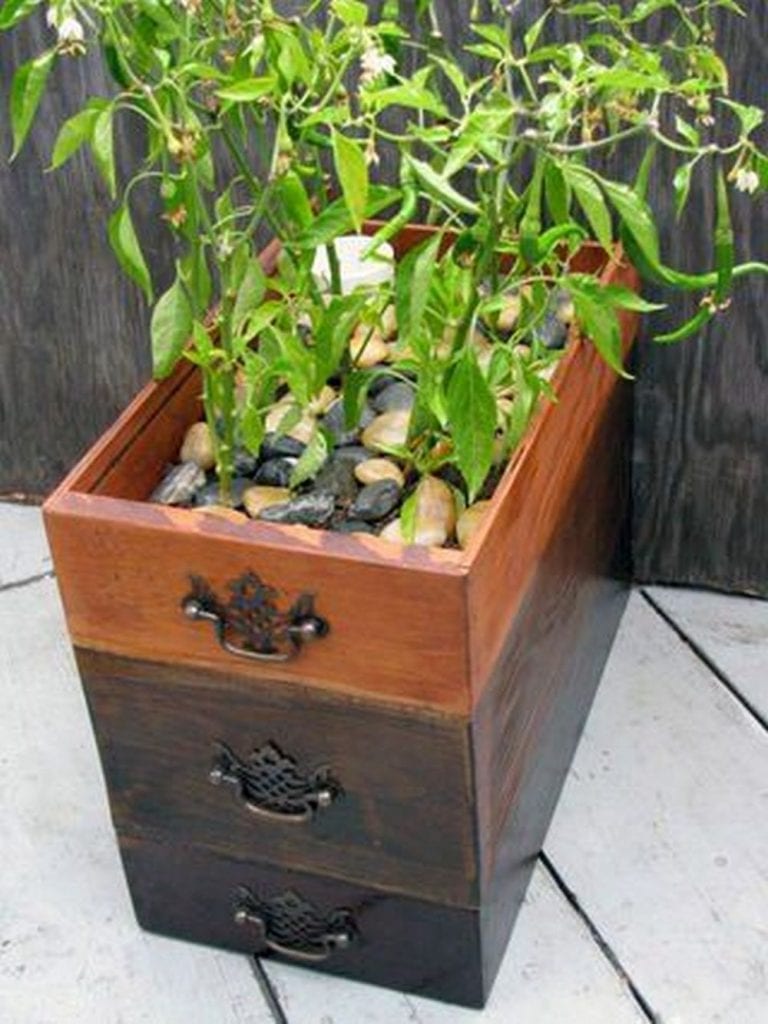
Design Ideas for Dresser Drawer Planters
Repurposing old dresser drawers into planters is an innovative and sustainable gardening solution. Not only do they add a touch of personality to your garden, but they can also be transformed into self-watering planters. This feature ensures your plants stay hydrated, even when you’re busy.
Here are some design ideas to inspire your next project.
Vintage Chic
Embrace the rustic appeal of an old dresser drawer. Sand it lightly but leave some of the original paint for a vintage look. Apply a sealant to protect the wood. Then, set up your self-watering system. This design adds a nostalgic touch to your garden.
Modern Minimalism
Paint your dresser drawer in a single, bold color. Black, white, or gray works well. Use a matte finish for a modern feel. The clean lines and simple color will make the greenery pop. Equip it with a self-watering system for a low-maintenance, modern gardening solution.
Bohemian Rhapsody
Mix and match different patterns and colors. Use painter’s tape to create geometric designs. Add beads, shells, or mosaic tiles. A bohemian-style planter thrives on creativity. Incorporate a self-watering system to keep your eclectic mix of plants happy and hydrated.
Fairy Tale Garden
Transform your dresser drawer into a magical fairy garden. Paint it in soft pastels. Add miniature houses, bridges, and figurines. Small succulents and moss give it a fairy tale look. A self-watering planter ensures this whimsical garden stays lush.
Industrial Edge
Go for an industrial look with a metallic paint finish. Choose shades of silver, bronze, or copper. Add metal labels or handles for authenticity. An industrial-style dresser drawer planter, equipped with a self-watering system, combines form and function.
English Cottage
Paint your drawer in soft, warm colors like cream or light blue. Add floral designs or decoupage with fabric or wallpaper. This style suits a variety of plants, from herbs to flowering annuals. A self-watering planter keeps them thriving with minimal effort.
Zen Retreat
Create a peaceful Zen garden within your drawer. Use neutral colors and natural materials like bamboo. Plant ferns, moss, or small bamboos. Add a miniature Buddha statue or stones for tranquility. A self-watering system ensures your Zen garden remains a serene retreat.
These design ideas for dresser drawer planters showcase how versatile and functional these pieces can be. With a self-watering system, your creative planter will look good and support healthy plant growth with less effort.
Maintenance and Care Tips for Self-Watering Planters
Self-watering planters are a boon for gardeners, simplifying plant care by automating the watering process. However, regular maintenance is essential to ensure they continue to function efficiently and support healthy plant growth.
Here are some maintenance and care tips to keep your self-watering planter in top shape.
Regular Water Reservoir Checks
Check the water reservoir of your self-watering planter regularly. Ensure it’s filled and functioning properly. During hot weather, water consumption increases. Regular checks prevent your plants from drying out.
Cleaning the System
Clean the water reservoir and wicking system every few months. Remove any debris or algae buildup. This keeps the water flow unobstructed and ensures your self-watering planter works effectively.
Monitor Soil Moisture
Even with a self-watering planter, it’s crucial to monitor soil moisture. The system maintains consistent moisture levels, but adjustments may be needed based on plant needs and weather conditions.
Refresh the Soil
Annually refresh the soil in your self-watering planter. Over time, soil can compact or become depleted of nutrients. Adding fresh potting mix replenishes nutrients, promoting healthy plant growth.
Inspect Plant Roots
Regularly inspect the roots of your plants. Overgrown roots can clog the water uptake system of your self-watering planter. Prune roots or repot plants if necessary to ensure proper function.
Adjust Fertilizer Use
Plants in self-watering planters may require less fertilizer. The consistent moisture level helps with nutrient uptake. Use a water-soluble fertilizer sparingly to prevent nutrient burn.
Prevent Overfilling
Avoid overfilling the water reservoir in your self-watering planter. Excessive water can lead to root rot or fungal growth. Always adhere to the recommended water levels.
Seasonal Adjustments
Adjust your watering routine with seasonal changes. Plants may need more water in summer and less in winter. Adapt the water levels in your self-watering planter accordingly to match plant needs.
By following these maintenance and care tips, you can ensure your self-watering planter remains a reliable and efficient tool for your gardening needs. Regular upkeep not only extends the planter’s life but also supports your plants’ vibrant growth.
Conclusion
Creating a self-watering planter is a clever way to ensure your plants receive consistent moisture, even in your absence. This project not only breathes new life into old dresser drawers but also promotes sustainable gardening practices. With a bit of creativity and basic materials, you can craft a functional and stylish self-watering planter that keeps your green space thriving.


